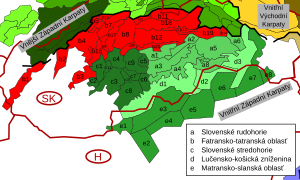
Back Фатранска-Татранская вобласць Byelorussian Фатранска-Татранская вобласьць BE-X-OLD Fatransko-tatranská oblast Czech Fatra-Tatra-området Danish Fatra-tatra regiono Esperanto Área de Fatra-Tatra Spanish Fatra-Tatra piirkond Estonian ფატრა-ტატრების ოლქი Georgian Fatra-Tatra Area LLD Fatra-Tatra-området NN
| Fatra-Tatra | |
|---|---|
 Kolový štít and Jahňací štít over Veľké Biele Pleso | |
| Highest point | |
| Peak | Gerlachovský štít |
| Elevation | 2,655 m (8,711 ft) |
| Coordinates | 49°10′N 20°8′E / 49.167°N 20.133°E |
| Geography | |
| Countries | Slovakia, Austria and Poland |
| Subdivisions | Branisko, Choč Mountains, Greater Fatra, Horehronské podolie, Hornád Basin, Kozie chrbty, Lesser Fatra, Little Carpathians, Low Tatras, Považský Inovec, Staré Hory Mountains, Strážov Mountains, Sub-Tatra Basin, Súľov Mountains, Tatras, Tríbeč, Turiec Basin, Upper Nitra Basin, Žilina Basin and Žiar |
| Parent range | Inner Western Carpathians |

The Fatra-Tatra Area (in geomorphology)[1] or the Tatra-Fatra Belt of core mountains (in geology)[2] is a part of the Inner Western Carpathians, a subprovince of the Western Carpathians. Most of the area lies in Slovakia with small parts reaching into Austria and Poland. The highest summit of the whole Carpathians, the Gerlachovský štít at 2,655 m (8,711 ft), lies in the High Tatras range which belongs to this area.
The Fatra-Tatra Area is from the northern side bounded by Pieniny Klippen Belt. Mountains of the area are located in two ranges. The external range consists of Hainburg Hills, Malé Karpaty (Pezinok part), Považský Inovec, Strážovské vrchy, Malá Fatra, Tatras (Western, High and Belianske Tatras). Inner range consists of Tribeč, Žiar, Veľká Fatra, Chočské vrchy, Ďumbier part of Nízke Tatry and massif of Smrekovica in the Branisko.[3] The southern boundary of Area is the Čertovica line, south of which is the Vepor Belt.
The Tatra-Fatra Belt consists of Tatric alpine crystalline basement and its autochthonous sedimentary cover, over which the Subtatric nappes (Fatric and Hronic) were thrust.[4]
The name core mountains is derived from the structural element, resistant crystalline basement rocks, preserved in the core of horsts, often forming the highest peaks of the mountains.
- ^ Mazúr, E., Lukniš, M. 1986: Geomorfologické členenie SSR a ČSSR. Časť Slovensko. Slovenská kartografia, Bratislava
- ^ Plašienka, D., Grecula, P., Putiš, M., Kováč, M. a Hovorka, D., 1997: Evolution and structure of the Western Carpathians: an overview. Mineralia Slovaca - Monograph, Košice, s. 1 – 24
- ^ Plašienka, D., 2006: Princípy regionalizácie geologickej stavby Malých Karpát a Považského Inovca. In: Kováč, M., Dubíková, K., Nové metódy a výsledky v geológii Západných Karpát. Zborník 2006, Univerzita Komenského, Bratislava, p. 51 – 56
- ^ Hók, J., Kahan, Š., Aubrecht, R., 2001. Geológia Slovenska. Archived 2011-07-19 at the Wayback Machine Univerzita Komenského, Bratislava, 43 p.
